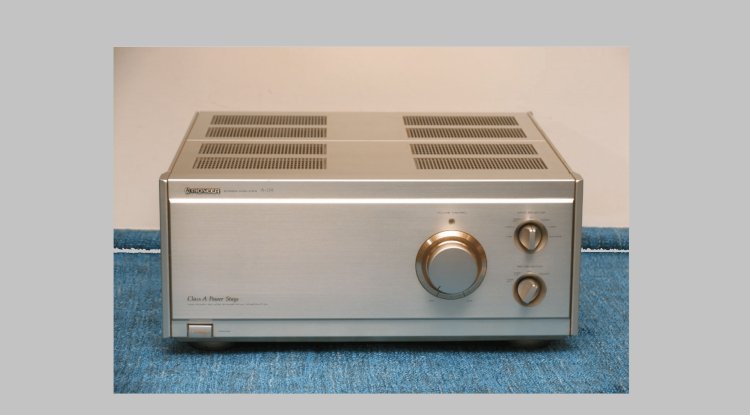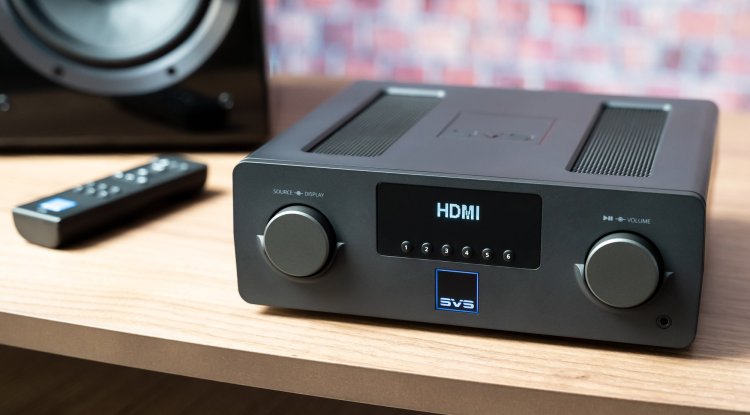Pioneer A-09 Amplifier - 1992 Release

Within the confines of the specific criteria of "Pioneer technician's Integrated Amplifier The highest-class Integrated Amplifier that has been warming the idea" for six years, even though it has expressed our will to the fullest extent, has adopted a simple circuit design for "a straight sound", as well as all of the technologies that it can have, such as Exclusive C7, and was born.
It is decided to use the symmetrical twin monophonic structure.
With a focus on the central power-source part, the shielding TAP box that summarized the input block of a small signal system right and left in the power block and the center of back of a large-current circuitry has been arranged, and the separation that was excellent with the symmetrical structure that considered the right-and-left channel circuitry as the independent stream composition has been gained.
Furthermore, it equalizes to environments such as temperature in the main unit, which influences the length of the right-and-left signal path length, or not only the stream composition of parts but also an operation of an element or circuitry, a magnetic-field distribution, an oscillation, and the occurrence of the electric and mechanical property error on either side.
The merit of the balance which directly linked two amplifiers and was excellent, and the Integrated Amplifier from which compactness is obtained is as it is, in order to achieve the purpose of the independent amplifier of operating the circuitry where the roles of a voltage amplification and current amplification differ proper, respectively, the pre-power isolated rate structure is embraced.
A nonmagnetic aluminum TAP box shields the included preamplifier circuitry (from an input terminal to the voltage amplification stage) for volume. Furthermore, this TAP box has a floating construction that is supported by a chassis using vibration suppression rubber, and the power-source part considers the pre part and the power part as independent stream compositions from the rectifier circuit, resulting in comprehensive separation.
Also, an electrically and physically isolated rate is formed so that a delicate input signal does not cause tone-quality failure due to circuitry interference from a power part, a variation of a power-source part, and oscillation as a result of this, and it has a structure that can also be referred to as the separate amplifier in a set.
The advanced direct construction is carried out, in which the direct construction that shortens a signal path as much as possible was developed further.
The volume unit and the signal changeover relay were controlled from the front panel, just behind the input terminal, and the input block was arranged in the back.
Much more shortest-ization is achieved by collectively arranging 16 power transistors of a power block.
A signal is directly sent from the input block to the power amplifier, and batch processing is performed in the amplifier back, resulting in a significant shortening of the path between Puri Power, which easily becomes a noise source, and the power speaker terminations.
Furthermore, it is that the buffer amplifier which the inside of an input circuit also arranged the signal changeover relay immediately after the input terminal, and has greatly improved the crosstalk between each source, and was mounted on the same substrate as a relay carries out a low-impedance drive, The outstanding channel separation is realized by low-impedance-izing of a circuitry
A power amplifier portion is enlarging the original superlinear circuit that performed pure Class-A operation and that Pioneer has cultivated to the final stage of a huge current, despite the final-stage an unreturned stream composition, and has realized the high damping factor 200.
As a chassis, the newly created high-precision one molding silent chassis is used.
Torsion-proof, impact-proof, and a newly created special resin substance that is excellent in secular change are developed and implemented. Internal and external oscillations are effectively reduced by forming it in a shape that suits each block while also firmly supporting the main unit.
For nonmagnetic, electromagnetic-induction noise and magnetic distortion are tightly controlled.
As a power-source portion, a stack-type electrolytic capacitor with low flux noise generated in a pure first-class amplifier is used, capacity sufficient with low flux density, and a power transformer with the exceptional regulation property is used, and the flux noise is very low.
As a volume, the handmade attenuator type with the same basic structure as Exclusive C7 is used.
Unlike the carbon resistor and high precision contact that is carefully selected one step at a time, and a sound volume is changed by a general slide resistor, there is little impact by a temperature, humidity, etc., the level difference of the tone-quality transition and right and left by contact resistance is removed, and stable control is enabled.
To cut through the design of a tone-quality first priority, it is dared to omit attached functionalities such as a tone control, a balance, a loudness, and the speaker output is also made into a single line. While this suppresses the delicate influence of the circuitry or switch points, it allows for the shortest-ization of an event of a product-line step or a signal path.
Furthermore, the grounding side of each input source was altered at the same time, and a separate grounding design was chosen to minimize signal interference between the connection assemblies from the grounding side.
The Phono equalizer has a single chip dual FET input configuration.
The input terminal has one balanced input and uses the dependable gilding termination for all terminations.
The mass very-thick type OFC power cord has been chosen. This power cord has adopted the strategy pulled from a case directly beneath a power transformer, and it is limiting the influence of external noise.
The high-class type carried out aluminum Naked shaving look, as well as the rotary knob, resistor, and capacitor that were carefully selected, are used.
The fraction that absorbs the generated heat by having carried out the intensive placement of the power transistor, as well as the fraction that diffuses effectively, were distributed, and a new heat-dissipation structure was adopted in which consideration was given to the location of a heat sink, form, and the path into which air flows.
Furthermore, a new type that adjusts the length of a fin and minimizes vibration is used as an aluminum heat sink.
| Form | Stereo Integrated Amplifier |
| Output power (both channel drive) | 35W+35W (8 ohm, 20Hz - 20kHz, 0.05%) 70W+70W (4ohm) |
| Dumping factor (8ohm) | 150 (20Hz - 20kHz) 200(1kHz) |
| Input sensitivity/impedance | Phono man-month: 2.5mV / 50kohm the compact disk, Tuner, Line, Tape:150mV /, 50kohm Balance: 150mV/600 ohm |
| Phono maximum permissible input | man-month: 150mV (1kHz, 0.05%) |
| An Output voltage/impedance | Tape Rec: 150mV / 1kohm |
| Frequency characteristic | Phono man-month: 20Hz-20kHz�}0.2dB the compact disk, Tuner, Line, and Tape:1Hz-150kHz+0 -3 dB |
| S/N (IHF, A network) Short circuit | Phono MM:87dB the compact disk, Tuner, Line, Tape: 109dB |
| Supply voltage | AC100V, 50Hz/60Hz |
| Power consumption (Electrical Appliance and Material Control Law) | 220W |
| Dimensions | Width 440x height 198x depth of 480mm |
| Weight | 28.8kg |




































